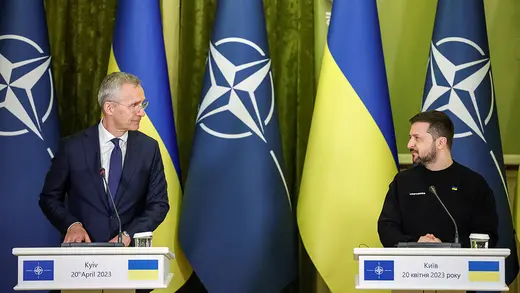The most complicated problem leaders of the North Atlantic Treaty Organization (NATO) will face at their July summit in Vilnius, Lithuania, is how to respond to Ukraine’s interest in joining the alliance. Member states want to strengthen NATO’s partnership with Ukraine, but they remain divided on crucial details—whether membership should be full or partial; immediate, gradual, or once again postponed; unconditional or linked to the outcome of the war. The near-coup led by Wagner Group chief Yevgeny Prigozhin in Russia will make all these divisions harder to resolve.
Embarrassing Comparisons
Decisions made at Vilnius will inevitably be compared to Western initiatives of the past thirty years that were intended to bolster Ukraine’s security but fell short:
More on:
- In the so-called Budapest Memorandum of 1994, the United States and Britain joined with Russia in promising to respect Ukraine’s “independence and sovereignty” once it relinquished nuclear weapons inherited in the Soviet Union’s collapse. Subsequently, however, Washington, London, and other NATO members did little to increase Ukraine’s ability to defend itself.
- At the 2008 NATO summit in Bucharest, Romania, Ukraine sought to begin the process of joining the alliance by getting NATO leaders to offer it a Membership Action Plan (MAP). But several member states resisted this step, and the summit declared only that Ukraine “will become” a member—at some unspecified future date. The prediction was not followed by any actions designed to bring membership closer.
- After Russia first seized Ukrainian territory in 2014, Paris and Berlin brokered a deal between Moscow and Kyiv that was supposed to, at minimum, end the separatist war in eastern Ukraine. These “Minsk agreements” (so called because the meetings were held in Belarus) foundered for lack of Russian interest in genuinely restoring Ukrainian sovereignty; they left the conflict stalemated.
A Better Benchmark?
The defects of these initiatives seem obvious today. They achieved a declaratory consensus but paid little attention to practical follow-through; they did not make Ukraine’s ability to defend itself a priority in its own right; they created no institutional framework for cooperation; and they let hope for good relations with Moscow limit relations with Kyiv.
NATO has now put the “Budapest-Bucharest-Minsk consensus” behind it. It recognizes that solemn declarations—absent real cooperation—contribute little to security. Its new approach takes the Russian threat to Ukraine as its starting point and aims to counter that threat without depending on Russian cooperation or good will. NATO wants security ties to Ukraine with a solid institutional structure that can assure their permanence.
The alliance is not, however, ready to transform Ukrainian membership from a goal into a reality. Russia’s brush with civil war will only add to this hesitation. As a result, the test of the coming summit’s success will be whether NATO can make its steadily increasing support for Ukraine seem meaningful enough that both the alliance and Kyiv treat the occasion as a true milestone on the way to lasting partnership.
The extraordinary flow of weapons, training, and intelligence to Ukraine, as well as the regular consultations of the Ukraine Defense Contact Group, have sustained the war effort since February 2022 and provide a credible foundation for continuing partnership. From almost nothing, Ukraine and its supporters have created the kind of security cooperation usually reserved for the closest of allies. Andriy Yermak, chief of staff to Ukrainian President Volodymyr Zelenskyy, says it rests on “historic, unprecedented trust.” At Vilnius, a new “NATO-Ukraine Council” will further upgrade Kyiv’s role in alliance deliberations. NATO leaders also seem likely to resolve the issue that divided them at Bucharest in 2008—whether to offer Ukraine a Membership Action Plan—by simply removing it as a precondition for membership. And they could, finally, be preparing to approve the delivery of new, upgraded weapons to Ukraine.
More on:
Enduring Questions
For all this, some errors of the past will cast an unavoidable shadow at Vilnius. With NATO still unwilling to set a timetable for Ukrainian membership, many observers—and Ukrainians in particular—will wonder whether Ukraine is really any closer to joining the alliance than it was after Bucharest fifteen years ago. Will it be just as far away fifteen years from now?
Ukrainians may feel the same way about another proposal now under discussion within the alliance: that NATO agree to take up Kyiv’s membership application once the war is over and a peace agreement is in place. Supporters of this idea hope to ease worries that membership for Ukraine could oblige NATO states to send troops to fight while the war is still underway. But the approach risks helping Russia keep Ukraine out of NATO simply by rejecting any settlement. If Western governments let Kyiv’s place in NATO depend on Moscow’s acquiescence, they will be repeating the same mistake they made at Minsk.
Because the alliance is not of one mind about Ukraine’s membership, its decisions at Vilnius can hardly avoid echoing past mistakes. To do better, Western governments have to emphasize those elements of NATO-Ukraine partnership on which a strong new consensus has already taken hold. The defense collaboration that has been created in sixteen months of war is unlike anything Ukraine has experienced in thirty-two years of independence—and without precedent in the almost seventy-five-year history of the alliance. Turmoil in Moscow only makes this partnership more vital. Its intensity, impact, and permanence are the most important messages NATO can send Russian President Vladimir Putin from Vilnius.
 Online Store
Online Store
